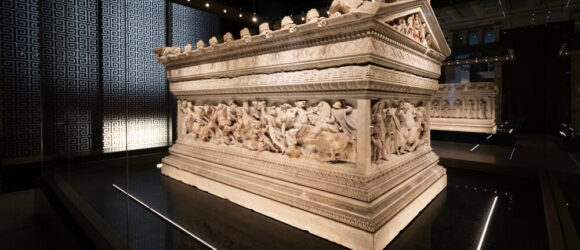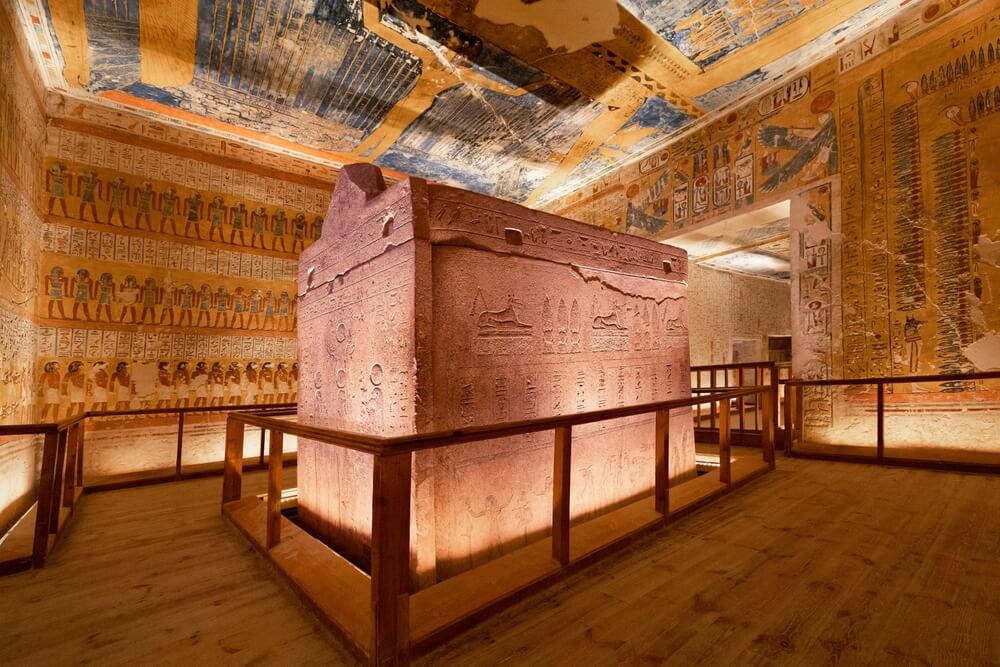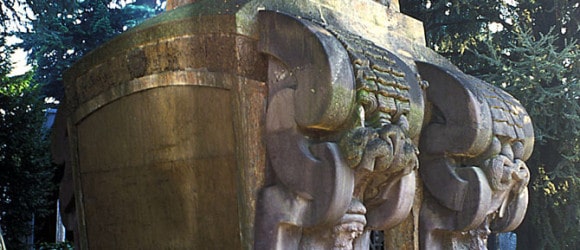What Is a Sarcophagus? From Ancient Egypt to Chernobyl’s Containment Solution
The word “sarcophagus” may conjure images of ancient kings in massive, sealed tombs. However, this fascinating structure has played many roles throughout history, from sacred burial chambers to emergency containment systems.
So, what is a sarcophagus? Let’s explore the meaning, origin of the word, and how this ancient term has become relevant in the modern world, particularly in the aftermath of the Chernobyl disaster.
Key Takeaways
- Definition and Origins: A sarcophagus is a stone coffin traditionally adorned with inscriptions or carvings. The word comes from Greek roots meaning “flesh-eating stone,” originally describing limestone believed to decompose bodies quickly.
- Cultural Significance: Ancient Egyptian sarcophagi were richly decorated and played a central role in burial rituals, intended to protect the mummy and guide the soul to the afterlife. Roman sarcophagi emphasized artistic expression, often carved with mythological scenes or family tributes.
- Modern Evolution: The term took on new meaning in the 20th century when it was applied to the concrete and steel containment structure built over Chernobyl’s damaged reactor, highlighting a shift from sacred burial to environmental protection.
- Enduring Symbolism: Across history, sarcophagi have symbolized humanity’s desire to honor the dead, preserve legacies, and safeguard the future, whether through ancient craftsmanship or modern engineering.
Sarcophagus Definition: A Tomb That Tells a Story
At its core, the definition of a sarcophagus is simple. It’s described as a stone coffin, typically adorned with a sculpture or inscription, and associated with the ancient civilizations of Egypt, Rome, and Greece.
The term comes from the Greek sarx (flesh) and phagein (to eat), translating to “flesh-eating stone.” This name originally referred to a type of limestone that was believed to decompose the body rapidly. But beyond its literal meaning, the sarcophagus represents ritual, reverence, and remembrance across civilizations.
The Egyptian Sarcophagus: Majesty and the Afterlife
No discussion of sarcophagi is complete without highlighting the Egyptian sarcophagus – arguably its most iconic form. Used by ancient Egyptians to entomb pharaohs and nobility, these massive burial containers were central to Egyptian religion and belief in the afterlife.
The earliest stone sarcophagi appeared in Egypt during the Old Kingdom (c. 2686–2181 BCE). They were carved with spells and symbols intended to guide the deceased into the afterlife. Over time, these evolved in design and detail. During the Middle Kingdom, sarcophagi began featuring more elaborate inscriptions, and by the New Kingdom, they were often painted, carved, and richly adorned with treasures.
Ancient Egyptians believed the sarcophagus protected the mummy. Protection of the body was essential for the soul’s eternal journey. In fact, a shining sarcophagus was symbolic of the deceased’s divine transformation. Food offerings, amulets, and sacred texts were placed inside to support them in the afterlife.
Roman Sarcophagi: Artistic Legacy
The use of sarcophagi didn’t end with Egypt. Roman sarcophagi, often crafted from elaborately carved marble, gained popularity during the second century CE. Unlike Egyptian sarcophagi, Roman versions frequently depicted mythological scenes, battles, or portraits of the deceased.
These sarcophagi were sometimes placed in family tombs and designed to hold multiple remains. Famous examples of both Egyptian and Roman sarcophagi are preserved in museums around the world today. The Metropolitan Museum in New York houses stunning specimens, including a painted Egyptian sarcophagus that once held three mummies, which were uncovered and studied using DNA analysis to reveal familial links.
The Chernobyl Sarcophagus: A Modern Meaning
Fast forward to the 20th century, and the word sarcophagus takes on an entirely new context. Following the 1986 explosion at the Chernobyl Nuclear Power Plant, Soviet engineers constructed a massive containment structure over Reactor No. 4—widely referred to as the Chernobyl sarcophagus.
This wasn’t a stone sarcophagus, nor was it made to honor the dead. Instead, it was a hastily built concrete and steel shell meant to contain radioactive material and prevent further environmental disaster. It functioned more like a barrier than a tomb, as it protected the world from the dangerous materials within.
The original structure deteriorated over time and was replaced in 2016 by a more secure steel enclosure known as the New Safe Confinement. Still, the Chernobyl sarcophagus remains a haunting symbol of how the term has evolved from honoring the dead to containing catastrophe.
One Word, Many Legacies
So, what is a sarcophagus? It’s more than just a coffin—it’s a legacy. From ancient Egyptian tombs to Roman artistry to modern nuclear disaster response, the sarcophagus has served as a guardian of both the sacred and the dangerous.
Whether painted, carved, or coldly utilitarian, preserving a mummy or encasing a reactor, the sarcophagus reflects humanity’s efforts to protect, preserve, and understand what we leave behind.
Preserve Your Legacy with Dignity
Whether you’re planning ahead or honoring a loved one, a custom-built mausoleum or sarcophagus offers a timeless tribute. Explore your options at Eternal Mausoleums and discover how you can create a lasting legacy.
Above Ground Cremation Vaults: An Alternative to Traditional Burial
As preferences around end-of-life arrangements evolve, many families are seeking meaningful alternatives to traditional burial. Among the most dignified and increasingly popular choices is the above-ground cremation vault—a structure that combines the permanence of a traditional monument with the flexibility of cremation. This type of above-ground interment provides a respectful and lasting way to memorialize the deceased, while offering comfort and convenience to those left behind.
Final Resting Place Options for Cremated Remains
- Secure and Dignified Option: Above-ground cremation vaults provide a respectful and lasting way to hold urns and honor the deceased.
- Meeting Modern Preferences: This type of interment reflects the growing demand for flexible above-ground burial alternatives.
- Personalization and Connection: Many vaults allow for custom features and the option to house multiple urns, creating meaningful final resting places for families.
- Long-Term Value: While potentially more costly than traditional interment, above-ground burials offer durability, convenience, and lasting emotional comfort.
What Are Above Ground Cremation Vaults?
An above-ground cremation vault is a specially designed structure that holds urns containing cremated remains. Often housed in mausoleum crypts, cremation monuments, or columbaria, these secure chambers are built above the earth’s surface. The urn rests in a sealed compartment, protected from the elements and thoughtfully displayed instead of being buried in the ground.
These mausoleums are often constructed of granite or marble and can be personalized to reflect the life and legacy of the deceased. Some are constructed in cemetery complexes, while others are standalone monuments in peaceful garden settings — perhaps on private land.
Why Choose an Above-Ground Cremation Vault?
In-ground burial has been the norm for centuries. However, many people seek a new approach to final resting places. Here are some reasons why above-ground cremation vaults and mausoleums are popular.
1. Aesthetic and emotional value
Above-ground cremation monuments provide families with a beautifully designed and easily accessible final resting place. These structures carry special meaning, often incorporating engraved plaques, photos, or decorative elements that celebrate a life well lived. The ability to visit and reflect in a serene space can offer great emotional comfort after death.
2. Convenient visitation
Unlike traditional burials, above-ground interment allows for more accessible visitation. Many of these cremation vaults are located in indoor mausoleum crypts or sheltered outdoor settings, making it easier for friends and family—especially those with mobility issues—to spend time remembering their loved one.
3. Durability and protection
By being housed in above-ground structures, cremation urns are better protected from the effects of time and nature. This level of care ensures that the memory of the deceased is preserved in a secure and respectful environment for generations.
4. Family companionship
Some above-ground interment options are designed to hold urns for multiple family members. This allows spouses or relatives to share a final resting place, providing a beautiful symbol of enduring love and connection.
Cost and Planning Considerations
Although above-ground burials may involve additional costs compared to simple in-ground interment, the investment often reflects the lasting quality, aesthetics, and peace of mind they offer. Costs may vary based on the funeral home, location, materials, and the type of monument selected. Families are encouraged to consult with a trusted funeral home or cemetery professional to explore options that align with their values and budget.
Of course, private mausoleum options are available for those families requiring privacy.
Is an Above Ground Cremation Vault Right for Your Family?
Choosing how to honor a loved one after death is deeply personal. An above-ground cremation vault offers a thoughtful alternative for those seeking a balance of tradition, beauty, and lasting tribute. Whether placed within mausoleum crypts, elegant garden niches, or custom cremation monuments, this type of interment reflects the growing demand for dignified, meaningful remembrance.
Are you beginning the pre-planning process and would like to learn more about above-ground interment for the discerning family? Request a private consultation with Eternal Mausoleums by Forever Legacy. We are the premier provider of funerary architecture in North America.
Selecting Mausoleum Crypt Plates: Materials, Designs & Inscription Options
- At May 02, 2025
- By Lin McLeod
- In General Information, Mausoleumpedia
 0
0
Every detail matters when honoring a loved one’s legacy. For example, selecting the right mausoleum crypt plate is one of those meaningful decisions. It’s more than a nameplate—it’s a permanent tribute reflecting a well-lived life. Whether planning ahead or making arrangements after a loss, this guide will walk you through the most important considerations when choosing a crypt plate, including materials, design elements, and inscription options.
The Basics: Mausoleum Crypt Plates
- Crypt plates serve as lasting memorials, often made from bronze, granite, or stainless steel, and are used to honor those buried or placed in a columbarium or niche.
- Families can personalize plates with relief artwork, portraits, and emblems—suitable for both cremated remains and traditional interments.
- Inscriptions typically include the full name, dates, and a short epitaph, with various font and finish options available for bronze markers and plaques.
- It’s important to ensure the plate complements the overall mausoleum site.
What Is a Crypt Plate?
A crypt plate—also called a crypt marker or nameplate—is the panel affixed to the front of a mausoleum niche or crypt. It identifies the individual entombed or buried within and typically features their name, birth and death dates, and a short epitaph or symbolic design. These plaques may be made from bronze, metal, or stone and are often attached to the exterior of the crypt or columbarium.
Crypt plates serve a dual purpose: they preserve identity and provide a beautiful and respectful tribute to the remains of a loved one.
Selecting Mausoleum Crypt Plates: Materials, Designs & Inscription Options
Choosing the right crypt plate is integral to planning or personalizing a mausoleum. Families often seek clarity in the process, and this guide will answer the most common questions surrounding materials, designs, and inscription choices.
1. Crypt plate materials
Durability, appearance, and compatibility with the mausoleum structure are key when choosing the material for a crypt plate. Common options include the following:
- Bronze: Known for its elegance and longevity, bronze crypt plaques offer timeless beauty. They are corrosion-resistant and ideal for private mausoleums or columbarium fronts.
- Stainless Steel: Sleek and modern, stainless steel works well in minimalist or contemporary mausoleum designs.
- Granite: Often used for shutter-style crypts or full-front designs, granite pairs well with matching headstones or mausoleum facades.
2. Design options for personalization
A well-designed crypt plate should reflect the individual’s legacy, beliefs, and personality. Popular design elements include the following:
- Relief Artwork: Raised details like borders, angels, doves, or flowers add depth to bronze markers or niche plaques.
- Portraits: Laser-etched or bronze-framed images can create a more personal, visual connection to your loved one.
- Emblems: Military medallions, fraternal insignias, or religious symbols can be included to honor service or values.
Design elements can be included in plaques accompanying cremated remains in a niche or traditional full-body interments.
3. Inscription styles and options
Inscriptions turn a nameplate into a heartfelt tribute. Key elements include:
- Basic Information: Full name, birth and death dates, and sometimes a maiden name or middle initial.
- Epitaphs: Short messages such as “Forever Loved” or spiritual quotes reflect emotional sentiment and meaning.
- Fonts and Finishes: Choose serif, script, or modern fonts with finishes ranging from polished to antique, particularly for bronze plaques or niche markers.
Helpful Tips for Choosing a Crypt Plate
- Confirm Requirements: Always obtain approval from the cemetery or columbarium before ordering. Some sites have specific size or material requirements for plaques and markers. Of course, this is not necessary if you’re constructing a private family mausoleum.
- Plan Ahead: Preplanning gives families peace of mind and allows for thoughtful customization.
- Coordinate with the Mausoleum: Make sure your bronze crypt plaque, niche plaque, or stone engraving aligns with the overall aesthetic of the mausoleum or burial site.
A Tribute That Stands the Test of Time
A mausoleum crypt plate is more than a marker—it’s a legacy in bronze, steel, or stone. Whether you’re commemorating cremated remains in a niche or honoring a loved one buried in a private crypt, your design should offer a sense of permanence, elegance, and emotional connection.
At Eternal Mausoleums by Forever Legacy, we specialize in designing and building custom mausoleums where every detail—down to the plaque—is a lasting expression of love. Contact us to begin creating a mausoleum that honors your family’s story for generations to come.
What’s the Difference Between a Mausoleum and a Memorial?
- At September 04, 2013
- By mausoleum
- In General Information
 0
0
When considering how to commemorate the life of a loved one, a family may contemplate a mausoleum, a memorial, or another commemorative structure. The terms can get confusing, though, so what’s the difference between a mausoleum and a memorial?
Read More»Uniquely Funerary: Pierd’Houy Family Mausoleum
- At March 28, 2013
- By Doug Keister
- In Doug Keister's Blog
 0
0
When I was photographing and researching my first cemetery book, Going Out in Style: The Architecture of Eternity, I kept coming across mausoleums that didn’t neatly fit into any definite architectural style. These eclectic mausoleums might have some Gothic spires, Classical Revival columns, and Egyptian symbolism. I started to call this odd and sometimes wonderfully whimsical architecture “Uniquely Funerary”. You just aren’t likely to find this style of architecture anywhere else but a cemetery, or perhaps a fanciful theme park. Indeed, Uniquely Funerary mausoleums and funerary structures are a triumph of form over function. They may be thought of as a delightful marriage of sculpture and architecture.
Read More»






